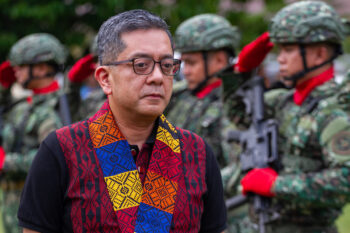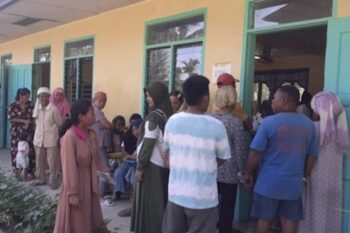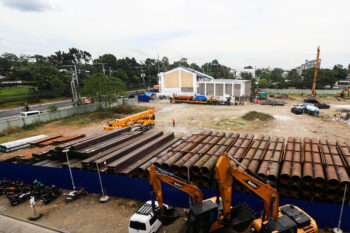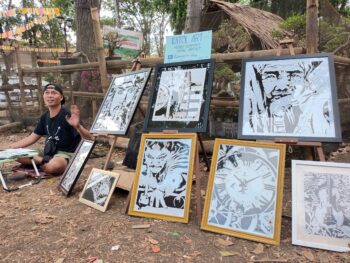DAVAO CITY (MindaNews / 10 Oct) – This coming Sunday, 13 October, the Roman Catholic Church throughout the Philippines will be celebrating the Indigenous Peoples Sunday. An activity conducted yearly by the Catholic Bishops Conference in the Philippines (CBCP) and the Episcopal Commission on Indigenous Peoples (ECIP), this celebration began in the late 1980s. In Mindanao it is usually referred to as Lumad Sunday, as Lumad is the popular term for indigenous peoples in southern Philippines.
On this day, local churches are supposed to sponsor activities (from Liturgical Celebrations to Educational to Cultural Festivities) that would celebrate the Lumad’s remarkable cultures and indigenous belief system but also to draw the citizenry’s attention to the injustices that they still continue to suffer in the hands of those who oppress and exploit them, especially in terms of dislocating them from their ancestral domain.
In parishes and chapels all over the country, one could see the poster announcing Lumad Sunday. This year, it indicates the theme for this celebration – Evangelization and Inculturation (Pagsangyaw sa Ebanghelyo pinaagi sa Lumadnong Kultura). The extent to which local churches provide adequate attention to the preparation and conduct of activities and how they go about the celebration of this important date, gives the faithful an idea how much they care about the Lumad’s plight.
Unfortunately, as in the past so many years, it is only in the dioceses and parishes who have full-time personnel assigned to this ministry and where there have been some level of organizing among the Lumad, where the celebrations this coming Sunday would fulfill the aims of having a Lumad Sunday. In most, there would only be token reference to the significance of this day. Most of the priests celebrating Mass on this day would not even refer to such a significant event. And for most Catholics, this Sunday will be no different than the other special Sundays commemorated yearly such as Mission Sunday, Prisoners’ Sunday and the like.
And yet it is not as if the Lumads constitute only a dot in the vast expanse of the Mindanao map. In terms of demographic presence, they are everywhere across Mindanao-Sulu, not just in the interior uplands. These days, they are making their presence felt in urban centers as their dislocations from their ancestral territories have pushed them to eke out a living in town and city centers. In the past, it was only during the Christmas season that they come down in droves to the city for caroling purposes; these days, they – especially their unemployed youth – come down and find work. In some cases, an increasing number of them are able to go to school.
The statistics involving the Lumad remains a major problematic. Until today – for all the efforts of the National Statistics Office (NSO) and the National Commission on Indigenous Peoples (NCIP) – a researcher finds it excruciating to secure accurate statistical data as to the population of the IPs in the whole Philippines, by region, by ethnolingustic group and by specific localities. The survey made by the Summer Institute of Linguistics (which appears in the website – ethnologue/com/country/PH/languages) list close to 130 languages (corresponding to ethnolinguistic groups) , with 52 residing in Mindanao-Sulu. A document that gathers data from the ECIP, NCCP-PACT, ONCC, OSCC, OMA and DENR has a list of 107 IP groups; of these number 39 are in Mindanao-Sulu. An AFRIM material that got its data from both the NSO and the NCIP Central office indicated 31 IP groups in Mindanao-Sulu. In all these lists, even Islamized IPs (e.g. Sama D’laut or the Badjaos, Iranun, Sangir, Kalibugan, Jama Mapon and Kalagan) are also included. There are confusions in terms of what names are used to refer to some groups; there are names that appear in one list but not in others.
The NCIP data (which I got from my student at the Ateneo Institute of Anthropology, ADDU who works with NCIP Regional Office based in Davao City) indicated that of a total Philippine population of roughly 92 million in 2010, 14 million belonged to the IPs. Thus they constituted 15.2% of the total population. More than one-half of the 14 million (51.2%) live in Mindanao-Sulu or a total of 7,165,432 people. These are staggering numbers if we look at the total population of small countries in Central America (Nicaragua, El Savador, Guatemala, Costa Rica and Panama); where most of their total population are roughly between 4 to 6 million only. With a total of 7 million in Mindanao and 14 million throughout the country, the IP populations are equivalent to that of countries. Even closer to us, look at Singapore’s population in 2012 – it is only 5,312,500.
Of the six regions in Mindanao, it is Davao Region with the highest IP population at 2,539,767. The lowest is in Soccksargen at 855,760. North Mindanao and the Zamboanga peninsula have more than a million. From the AFRIM data (as of 2007), the biggest IP group in terms of population is the Subanen in Western Mindanao with a total of 1,131,031, followed by the B’laan (841,702), Mandaya (670,613), Matigsalug (485,756), T’boli (425,125) and Bukidnon (417,793). The Manobo would have constituted a big number, except that they are subdivided into the Ilianen (58,288), Tigwayanon (20,301), Umayamnon (143,896), Obo-Manobo (34,035), Agusanon Manobo (259,050) and a few more sub-tribes.
Fr. Mateo Gisbert SJ, in 1886 (perhaps the first survey in Davao) identified the Lumads living across the Davao Gulf in 1886 and came up with his estimate of the population. There were 6,400 Guiangans, 10,000 to 12,000 Bagobo, 20,000 B’laans, 12,000 to 14,000 Kaolos, 1,200 Manobos and 25,000 Atas (data is from Mac Tiu’s Davao 1890-1910: Conquest and Resistance in the Garden of the Gods). The Matigsalug and Obo-Manobo could have been lumped together under the Ata. The Bagobo included the Klata-Djangan and Tagabawa. Thus today, Davao City’s Kadayawan Festival celebrates the rich cultures of its 10 recognized tribes, namely, the Ata, Matigsalug, Ovu-Manobo, Klata-Djangan, Tagabawa, Tausog, Maguindanao, Maranao, Kagan, and Sama. Jesuit records at that time also mention the Dibabawons and Mangugangans in North Davao, the Mansakas in northeastern part and the Mandayas in the eastern part, the Kalagans; but there is no indication of numbers.
Today the existing set of statistics available are confusing. Any interested researcher will find it all so frustrating to have reliable data. Part of the problem is the manner that the NSO gather its statistics which do not ask people to identify their ethnicity. And with the intermarriages of various ethnolinguistic groups (including Lumad and migrant settlers), identification of ethnicity becomes problematic. One does ask the question: what are the politics involved in the lack of political will on the part of government agencies and LGUs to have accurate statistics of our Moro and Lumad communities?
The fact of the matter is that in the NSO 2010 data, 51.4% of Mindanawons speak Bisaya (mainly Cebuano followed by Ilongo). Only two indigenous languages in Mindanao (Maguindanao and Maranaw) are spoken by a considerable number of people (5.5% for the former and 5.4% for the latter). The rest of the population (31.3%) speak the myriad languages of both Lumad and migrant settlers.
Christians (mainly the descendants of migrant settlers) have now dominated the population in Mindanao as of 2010. Of the total population 71.71% are Christians (69.9% Catholics and 10.81% Protestants), 20.44% are Muslims and the rest (7.85%) belong to a variety of faith traditions. Proselytization among the Lumad communities by Catholic and Protestant missionaries have led to baptisms. It would be most difficult to determine what percentage of Lumad conversions constitute the total Christian population in Mindanao today.
As a final note to this essay, Christians, specifically Catholics, are being encouraged by the bishops to find time this coming Sunday to reflect on the plight of our Lumad brothers and sisters. Among us, they are the poorest and most exploited by those who hold political, economic, social and cultural power and capital, especially those in control of mining and logging firms as well as agri-business plantations, but also small-time businessmen and politicians as well as the various armed groups. The richness of the Lumad cultures and belief system are now under attack because of the influences of Western-dominated globalization as well as by tourism.
Fortunately, there are pockets of resistance and in some of these oasis, there is hope that valuable aspects of their indigenous cultures will survive even as changes will take place. We will all be blessed if we do all we can to make sure that the legacy of our indigenous ancestors do not disappear in our midst; and that these will still be passed on from generation to generation.
(MindaViews is the opinion section of MindaNews. Redemptorist Brother Karl Gaspar of Davao City, former head of the Redemptorist Itinerant Mission Team and author of several books, including “To be poor and obscure,” and “Mystic Wanderers in the Land of Perpetual Departures,” writes two columns for MindaNews, one in English [A Sojourner’s Views] and the other in Binisaya [Panaw-Lantaw].)







